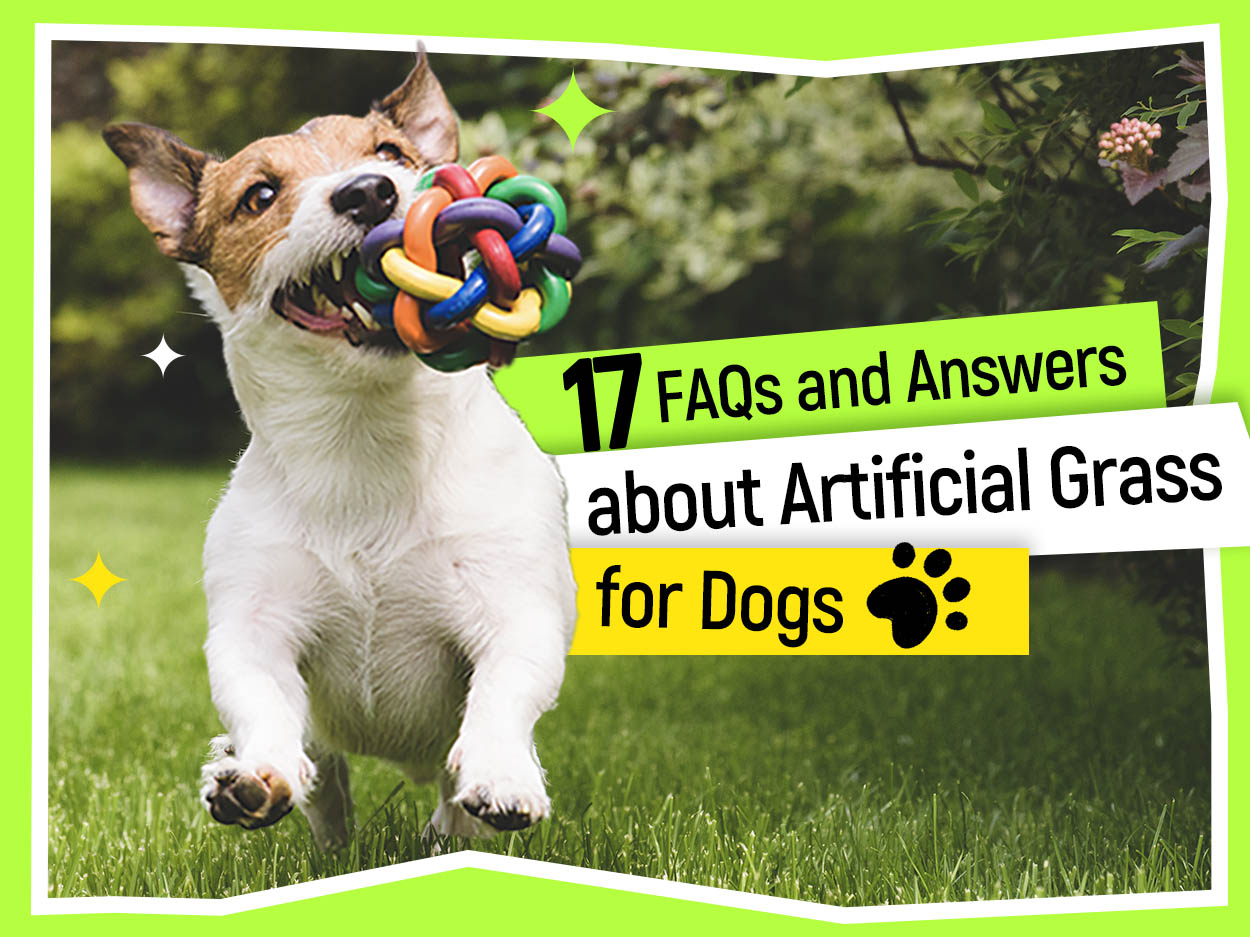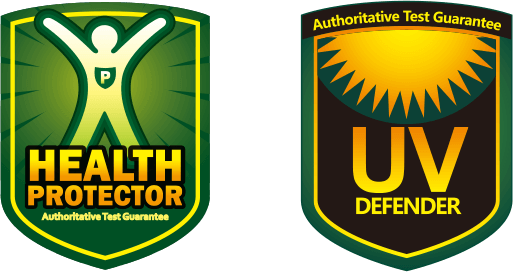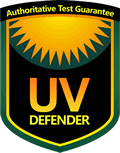17 FAQs and Answers about Artificial Grass for Dogs
- 2023-09-06
Artificial grass is rapidly gaining popularity as a convenient and comfortable solution for pets and their owners. Whether you’re dreaming of a cozy play area for your furry pals or aiming to make garden maintenance a breeze, artificial grass for dogs is becoming the go-to choice.
In this article, we’ll explore the top 17 FAQs about fake grass for dogs. From safety concerns to maintenance tips, by the end of this guide, you’ll have a comprehensive understanding of how artificial grass can enhance both your pup’s playtime and your outdoor living experience.
Table of Contents
Toggle- Q1: Real grass vs. Fake grass: Which is better for dogs?
- Q2: What is artificial grass for dogs made of?
- Q3: Is artificial grass safe for pets?
- Q4: What is the difference between pet turf and artificial grass?
- Q5: Can dogs pee and poop on artificial grass?
- Q6: How to clean dog urine from artificial grass?
- Q7: How to clean pet turf after dog poop?
- Q8: Does pet turf smell bad?
- Q9: Can dogs dig up artificial grass?
- Q10: Does artificial grass burn dogs’ paws?
- Q11: Can dogs be allergic to artificial grass?
- Q12: Can fleas & ticks live in artificial grass?
- Q13: Does pet turf get muddy?
- Q14: What is the best artificial grass for dogs?
- Q15: How long does fake grass for dogs last?
- Q16: How to maintain artificial grass for dogs?
- Q17: How much does fake grass for dogs cost?
- Conclusion
Q1: Real grass vs. Fake grass: Which is better for dogs?
In the choice between real grass and artificial turf for your dog’s outdoor area, both convenience and sensory appeal deserve consideration.
Real grass provides a natural playground—a tactile wonderland with its soft texture and natural scents. However, it demands consistent maintenance, including watering, mowing, fertilizing, and addressing pet-related wear and tear.
In contrast, artificial grass shines with convenience by eliminating such upkeep. It maintains a lush appearance without patchy spots. While it might warm in sunlight, advancements enhance its pet-friendly comfort.
Your choice rests on your lifestyle and your dog’s preferences. Whether you lean toward real grass or artificial turf, create a secure outdoor haven where your furry friend can thrive.
Q2: What is artificial grass for dogs made of?
Artificial grass for dogs is usually made from synthetic materials like polyethylene and polypropylene, which are safe for pets and provide a realistic feel.
Q3: Is artificial grass safe for pets?
Absolutely. Your pets’ safety is a priority. Reputable artificial turf manufacturers subject their products to rigorous health tests, including REACH, EN71-3, ASTM, DIN, and more.
These tests verify that the grass is free from harmful components like heavy metals and substances of concern, making it a safe and non-toxic choice for your furry companions. When selecting artificial grass for dogs, inquire about these certifications to create a secure environment.
Q4: What is the difference between pet turf and artificial grass?
Pet turf is a specialized artificial grass for pets, offering improved drainage, durability, and odor resistance.
Modern pet-friendly turf incorporates a fully permeable backing, facilitating water and dog urine flow through the entire backing.
On the other hand, traditional turf has a hole-punched backing with spaced holes. While this aids water drainage, it can also lead to liquid accumulation, especially with dog urine, promoting the growth of odor-causing bacteria.
Furthermore, many high-quality pet turf products now come with antibacterial protection, adding an extra layer of defense. This not only boosts turf hygiene and lifespan but also guarantees a safer and more comfortable environment for your pets.
Q5: Can dogs pee and poop on artificial grass?
Yes, they can. Dogs can play, rest, and relieve themselves on artificial grass. Unlike natural grass, synthetic turf doesn’t absorb or decompose dog waste components. Cleaning is also hassle-free—just use a hose for most spot treatments.
Q6: How to clean dog urine from artificial grass?
Thanks to the drainage backing, the urine is naturally handled. You don’t have to clean the turf after every urination. It’s suggested to hose down the pet turf once a week, especially if it hasn’t rained, to remove any residue.
Q7: How to clean pet turf after dog poop?
Cleaning dog poop from turf is similar to caring for natural grass. Let the waste dry a bit to prevent smearing, then use a doggy bag or scooper for solid waste. If dealing with diarrhea, remove as much as possible with a bag or paper towels. Finally, thoroughly rinse the turf fibers with a hose to make sure no residual dog poop is left behind.
Q8: Does pet turf smell bad?
Fake turf for dogs is odorless. Any odors that arise are usually due to urine or feces left on the artificial lawn for an extended period. Fortunately, dealing with stubborn odors is relatively easy. You can use a mixture of equal parts water and vinegar to spray the areas your pet frequents. Additionally, opting for pet turf with antimicrobial protection can effectively mitigate the buildup of unpleasant odors.
Q9: Can dogs dig up artificial grass?
Rest assured, they can’t. Pet-friendly synthetic turf is designed to withstand repetitive use and resist damage from dogs. With proper installation, digging is virtually impossible on synthetic grass.
Q10: Does artificial grass burn dogs’ paws?
Artificial grass doesn’t retain heat like pavement, rock, or brick, though it may not stay as cool as natural grass. If you worry about your dogs’ paws getting uncomfortably warm, it’s wise to ensure a shaded area is available for them to seek refuge.
For a quick solution, a hose rinse can significantly reduce the temperature of the turf. In regions with intense heat or for those seeking self-cooling grass, the CCGrass GrassCool series is an option to consider, which can be up to 10℃ cooler than regular surfaces.
Q11: Can dogs be allergic to artificial grass?
Artificial lawn is a pet-friendly option that is hypoallergenic and devoid of allergens. Unlike real grass, synthetic pet turf doesn’t release pollen, a common allergen. Plus, it eliminates the need for herbicides, pesticides, and fertilizers that can leave behind chemicals that might trigger allergies in dogs.
Q12: Can fleas & ticks live in artificial grass?
Synthetic grass is made from non-organic materials, which makes it difficult for fleas, ticks, and other pests to inhabit. While it doesn’t ensure complete eradication, the absence of soil limits their nesting spots.
However, it’s important to note that debris accumulation, such as leaves, could foster breeding. Regular cleaning of your synthetic yard remains crucial for effective pest prevention.
Q13: Does pet turf get muddy?
No, fake grass for dogs remains mud-free even in wet conditions. This means you can bid farewell to dirty paws and paw prints around your home!
Q14: What is the best artificial grass for dogs?
Selecting the ideal artificial turf for dogs depends on different climates and surroundings. Instead of seeking a sole “best” option, take into account these essential aspects:
- Short pile height (around 25mm) foreasy waste cleanup
- Fully permeable backing for excellent urine and water drainage
- Antimicrobial protection for a fresher, more hygienic environment
- UV-resistant artificial grass for enhanced longevity and fading prevention
- Warranty for lasting durability (up to 10 years)
For more in-depth information on choosing artificial grass for your beloved pets, refer to The Most Comprehensive Buyer’s Guide on Artificial Grass for Dogs & Pets
Q15: How long does fake grass for dogs last?
The longevity of artificial grass is influenced by factors such as usage, foot traffic, yarn type, installation quality, and maintenance. Our synthetic turf for dogs is designed to provide lasting value, with an expected lifespan ranging from 8 to 10 years or potentially even longer.
Q16: How to maintain artificial grass for dogs?
You’ve learned about waste handling, but what about ongoing care? Maintaining pet-friendly artificial grass is refreshingly simple. Unlike natural grass, there’s no need for constant watering, mowing, or chemical treatments. Here’s a brief overview of how to ensure its lasting beauty:
- Clear debris: Regularly sweep off pet hair, debris, and fallen leaves from the turf.
- Regular rinsing: Periodic rinsing helps remove dirt and keeps it looking fresh.
- Gentle brushing: Gently groom the grass blades to keep them upright and prevent matting.
- Swift stain action: Combat spots and messes promptly with mild soap and water, thwarting residue buildup.
Related reading:
Artificial Turf Cleaning and Maintenance: Tips for Long-Lasting Beauty and Hygiene
Q17: How much does fake grass for dogs cost?
The cost of artificial grass for dogs varies based on several factors tailored to your project. These factors might influence the overall price and include:
- Your preference for specific artificial grass products
- Dimensions of the designated area
- The volume of materials required for installation
- Design complexities, if any
- Labor intensity, encompassing tasks like turf removal or debris clearing
It’s recommended to request quotes from reputable suppliers and installation professionals to get a more accurate estimate based on your specific needs.
Conclusion
Pet turf offers a host of advantages, including softness, easy maintenance, water and cost savings, and versatility in various settings. This renders it an ideal choice not only for residential areas but also for commercial spaces such as dog parks, kennels, shelters, and veterinarian facilities.
Armed with insights into the 17 common queries, you’re now well-prepared to embrace a comfortable and functional haven for your dogs. If you have any questions or would like to know more about our artificial grass for dogs, please feel free to reach out to us at +86 25 6981 1666 or via email at [email protected].






 Tel:
Tel:  E-mail:
E-mail: 
